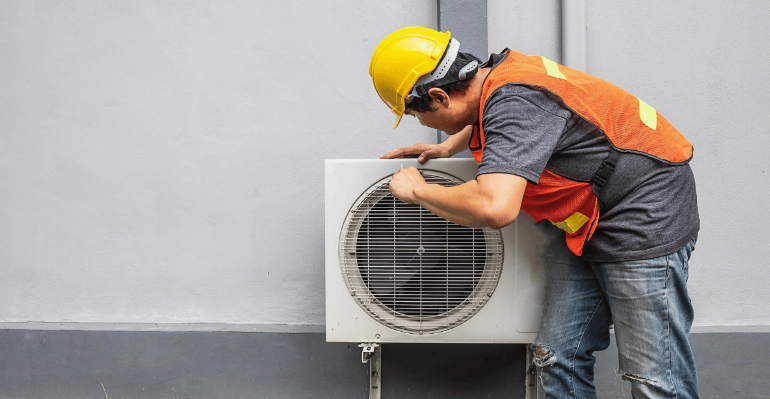How to Test HVAC Capacitor: A Step-by-Step Guide

The capacitors in HVAC are essential to initiate and maintain the operations of the system’s motors. These actually store and release electrical energy, which helps the system run smoothly and efficiently. Testing the HVAC capacitors is required to ensure the system runs smoothly.
Moreover, testing the capacitors helps you detect any issue, inefficiency, or system failure at an early stage. Experts like Francis Kaspar from The Chill Brothers suggest testing the capacitors to find any potential problems.
How Does an HVAC Capacitor Work?
HVAC systems typically have two types of capacitors. The start capacitors work during the motor’s initial phase until it gains speed; likewise, the run capacitors work after startup to run the motor operations.
These capacitors initially store electrical energy. When you turn on the HVAC system, the capacitors release the previously stored energy, which helps it run through the motors.
However, if you notice your HVAC system is struggling to start, shutting down randomly, making noise, or your energy bills are getting higher, this is a sign that your HVAC capacitor may not be running well. To ensure that the problem is in the capacitor, test HVAC capacitors.
Necessity of Testing an HVAC Capacitor
The entire performance of your HVAC system depends on the HVAC capacitor. Testing the capacitor is essential for maintaining the system’s efficiency and avoiding dangerous occurrences.
- Testing the capacitor can prevent sudden failure of the entire system and reduce repair costs. If you do not test it, potential issues may not be detected, and the system will break down suddenly.
- Capacitor testing can reduce your energy bills if found faulty. The faulty capacitors draw more power to run the system.
- Testing ensures problem detection at an early stage. It also decreases the possibility of failure at a premature stage.
- It ensures effective functioning and optimizes the efficiency of the system.
- Testing the capacitor helps to reduce the repair costs or new air conditioner installation costs if problems are found at an early stage.
Tools Required for Testing an HVAC Capacitor
You will require some tools to test the capacitors. Experts like The Chill Brothers’ Francis Kaspar suggest using these tools to test the capacitors effectively.
| Tools | Brief Description |
| Digital Multimeter | A digital multimeter helps determine whether the capacitor is within the acceptable range. Pick a multimeter with capacitance (µF) settings. |
| Insulated Screwdriver | It will help you discharge the capacitor safely before testing. Moreover, it helps to avoid electric shock. |
| Non-contact Voltage Tester | It verifies whether the power is off. This voltage tester will protect you from getting an electric shock. |
| Needle-nose Pliers | These pliers have precise tips that help to handle tight spaces and disconnect the capacitor’s spade connectors. |
| Safety Gear | For protection, use safety gear like insulated gloves, safety goggles, etc. |
| Capacitor Tester | It is an optional tool similar to a multimeter but more precise and accurate for capacitance reading. |
| Documenting Essentials | Use a notebook and pen to document and analyze the capacitor readings later. |
Steps to Test an HVAC Capacitor
Testing the capacitor is required for the smooth operation of your HVAC system. You can test it by using a capacitor tester or digital multimeter. Here’s how to test HVAC capacitors safely and effectively.
- Switch Off the HVAC System
The basic thing you should do while handling any electrical components is turn off the power. You can avoid possible electric shocks through it. To ensure the power supply has turned off, use a non-contact voltage tester for checking.
- Locate and Discharge the Capacitor
Generally, the capacitor is located in the outside part of the HVAC unit, which is recognized as the condenser unit. The capacitor can be oval-shaped or cylindrical with some terminals on the top. Take your insulated screwdriver to access the capacitor. Then, the stored energy within the capacitor is safely discharged.
- Disconnect the wires
Remove or disconnect the wires that are connected to the capacitor’s terminals. Use the needle-nose pliers to complete this task. Remember, before removing the wires, take a picture or note which wire connects where. It will help you to reassemble the wires later.
- Set up the Multimeter
If you are using a digital multimeter, turn it on and set it to the capacitance (µF) mode. The resistance (Ohms) mode will work too, if your multimeter does not have the capacitance mode. But experts like The Chill Brothers suggest using the capacitance mode.
- Test the Capacitor
If there is a single capacitor, you don’t require any specific polarity. Just place the multimeter probes on each terminal (Common and motor terminal). However, dual capacitors have three terminals.
Common terminal (C): For both motor and compressor.
FAN terminal: For fan motor.
HERM terminal: For compressor motor.
Place the probes of the multimeter first on the common terminal or “C” terminal and FAN terminal. Then again, place them on the “C” terminal and HERM terminal.
- In the case of Testing with a Capacitor Tester
If you are testing the capacitor with a capacitor tester instead of a Multimeter, go with the same connection process. It will give you more precision than a multimeter does. Moreover, capacitor testers can also read Equivalent Series Resistance (ESR) to find internal resistance.
- Read and Compare the Results
For both a multimeter and a capacitor tester, the acceptable reading is 5 to 10% of the rated capacitance value. You will find the rated value labeled on the side of the capacitor. Within this range, the capacitor is considered to be healthy and functioning properly.
If you find the reading below the 5 to 10% range, the capacitor is losing its capacitance and about to fail. However, if the reading is higher than the range, it also means the capacitor is faulty. If the reading is 0 or doesn’t register a reading, it indicates the capacitor has completely failed.
- Inspect the Capacitor Visually
It is essential to inspect the capacitor visually if there is any burn mark, leaking, or other physical damage. If you find these kinds of damages, replace the capacitor immediately.
- Reassemble the Unit
If there are no potential issues, it indicates the capacitor is healthy. In such a case, reconnect the wires and reassemble the unit properly. You can also reassemble the unit with a new capacitor if the old one is faulty. Make sure you are using the same safety gear as before to avoid risks.
Tips from experts on testing the capacitor
Knowing how to test an HVAC capacitor is not enough unless you use some expert tips and techniques. It will ease the process and help you avoid undesirable occurrences.
- Capacitors hold a residual charge even after turning off the system. So, check whether the power supply is turned off properly.
- Never rely on visual inspections only.
- Check wire continuity to detect broken wires or loose connections.
- As capacitance readings fluctuate with temperature changes, consider the temperature during testing of the HVAC capacitors.
- Inspect the terminals to see whether there is any discoloration or burns. These can be the early signs of capacitor failure.
- Handle old capacitors with Extra safety measures. Try not to touch metal surfaces.
- If you find the capacitor is in the worst condition, replace it. The whole unit is sometimes affected when the HVAC professionals suggest a new air conditioner installation.
Warnings on Testing an HVAC Capacitor [Do Not Ignore]
Testing an HVAC capacitor is essential to maintain the HVAC system’s performance and efficiency. Many experts like The Chill Brothers warn about some typical mistakes we make. Try not to fall for these mistakes and ensure your safety. Always use the safety gear and tools while testing.
Remember, single capacitor and dual capacitor testing are not the same. Moreover, capacitor testers can provide more accurate capacitance readings than multimeters. Try documenting the wiring before testing. Even if the testing goes right and the capacitor is healthy, the wrong reassembly can pose a considerable safety risk.




